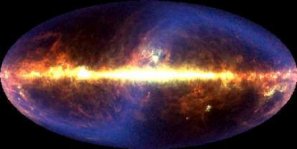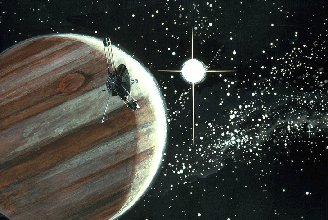There is a bright disc of interplanetary dust particles that surrounds our solar system, starting beyond the orbit of Saturn and stretching beyond the outer reaches, according to European astronomers. The discovery could lead to a speedier way of determining whether distant stars have their own planets too.
Markus Landgraf of the European Space Agency and colleagues have obtained the first direct evidence of a bright dust disc surrounding our Solar System and they reckon it should help illuminate the search for planets orbiting other stars in our galaxy. The finding will help mission planners short list stellar candidates for observation with ESA’s future planet-search missions, Eddington and Darwin.

Markus Landgraf
Planetary systems are thought to condense from a cloud of gas and dust. Planets form near the central star, where the material is densest. However, at great distances from the star, the gas and dust is sparse and can coalesce only into a vast band of small, icy bodies. A dust ring would therefore seem indicative of a mature star with a planetary system. In our Solar System, the dust particles that reach out beyond the orbit of Neptune form the Edgeworth-Kuiper belt. The dust is continually lost to deeper space though and according to Landgraf there has to be something to replenish it for the disk to be maintained. Indeed, 50 tonnes of dust have to be produced every second.
If you have a dust disc around a star that’s not particularly young, then it’s extremely interesting because the dust has to come from somewhere. The only explanation is that the star has planets, comets, asteroids or other bodies that collide and generate the dust, explains ESA’s Malcolm Fridlund.

Traces of the disc surrounding our Solar System are visible in this image taken by COBE. The blue band curving across this image is created by the dust disc surrounding our Solar System (Copyright Michael Hauser (Space Telescope Science Institute)
To prove the existence of the dust disk, Landgraf and colleagues sieved vast quantities of NASA’s Pioneer 10 and 11 data from the 1970s and early 1980s. These spacecraft found dust particles of unknown origin beyond Saturn’s orbit. It was initially suggested that the dust might come from comets but these objects only discard dust when they are close to the sun, they are frozen solid beyond Saturn. They compared the size of the dust particles from beyond Saturn with those measured by ESA’s Ulysses spacecraft, which has orbited the poles of the Sun for more than a decade.

Artist’s impression of Pioneer’s Jovian fly-by
The interstellar grains detected by Ulysses are typically ten to a hundred times smaller than the smallest grain that could be detected by Pioneer. Thus, the Pioneer grains have to be made somewhere within our Solar System.
The only plausible origin is collisions between the small, icy objects in the Edgeworth-Kuiper belt. Since these are the remnants of planet formation, the team believe that planetary systems around other stars will also produce constantly replenishing dust rings.
Brightly shining discs around the stars Vega and Epsilon Eridani have already been observed and the ESA results hint that these discs are evidence of their planets. If we see a similar dust ring around a main sequence star (a mature star, like the Sun), we’ll know it must have asteroids or comets. If we see gaps in the dust ring, it will probably have planets which are trapping the dust grains in resonant orbits, or ejecting them from the Solar System during close encounters, explains Landgraf.
The results appear in the May 2002 issue of The Astronomical Journal
Further reading
Suggested searches
Interplanetary Dust Particles
Extrasolar Planets